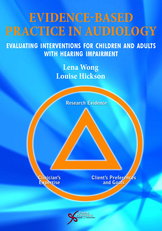Publication
Evidence-Based Practice in Audiology
Evaluating Interventions for Children and Adults with Hearing Impairment
- Edited by: Lena Wong, Louise Hickson
- Details:
- 356 pages, Illustrated (B/W), Softcover, 7 x 10"
- ISBN13:
- 978-1-59756-419-9
- Release Date:
- 02/21/2012
Overview
Evidence based practice (EBP) has proponents in all areas of healthcare and was endorsed in a technical report in 2004 and a position statement in 2005 by the American Speech-Language-Hearing Association. Despite this, there is no text on EBP with specific application to audiology. It is particularly important in audiology, where there are various interventions to assist people with hearing impairment and a growing body of research evidence that needs to be appraised by clinicians and researchers.
This comprehensive book describes the principles of EBP as they apply to the evaluation of audiologic interventions in children and adults. The reader will learn the process of EBP, as well as gain knowledge on the evidence relating to specific interventions. Evidence Based Practice in Audiology is divided into four sections. The first section describes principles of EBP, including how to evaluate evidence and how to facilitate evidence based decisions with clients. The remaining three sections provide a discussion of the best available evidence about hearing aids, cochlear implants, and other interventions. These three sections contain chapters written by leading international authors who summarize the best available evidence, highlight where further evidence is needed, and recommend how further evidence should be collected and applied in the clinic. The book ends with an appendix that contains recommended measures for the collection of evidence about different audiologic interventions.
Evidence Based Practice in Audiology is a highly valued resource for students, researchers, clinical audiologists, other health professionals and policy makers. For students, the book can be used for learning about research methods and about outcomes of interventions for children and adults with hearing impairment. For researchers, the book provides a useful summary of available research on important topics in habilitation and rehabilitation and may assist them to design future research studies. For clinical audiologists, the book can help them understand what evidence is and how this can be applied in clinical practice. Other health professionals who can benefit from this book include ENTs, pediatricians, geriatricians, GPs, nurses, and aged care workers. The book can also guide policy makers and third-party payers in their decisions about allocation of resources. The text is written with sufficient information for readers with different backgrounds and experience and careful attention has been paid to presenting complex information in an easy to understand format.
Evidence Based Practice in Audiology is edited by two leading academics in research in audiologic interventions. These editors have a rich clinical experience working with children and adults with hearing impairment and with other health professionals.
Review
Doody's (May 2018):
"Named to Doody's Core Titles in the Health Sciences - Speech, Language & Hearing 2018 list."
Foreword
Preface
Acknowledgement
Contributors
Dedication
Chapter
Part I: Principle of Evidence-Based Practice (EBP)
1. Evidence-Based Practice in Audiology
Lena Wong and Louise Hickson
2. Evaluating the Evidence on Audiologic Interventions
Michael Valente, Maureen Valente, and Laura Czarniak
3. Matching Evidence With Client Preferences
Ariane Laplante-Lévesque, Louise Hickson, and Linda Worrall
Part 11: Hearing Aids
4. Hearing Aids for Adults
Larry E. Humes and Vidya Krull
5. Hearing Aids for Children
Teresa YC Ching
6. Evidence-Based Practice and Emerging New Technologies
Gitte Keidser
Part III: Cochlear Implants
7. Evidence About the Effectiveness of Cochlear Implants for Adults
Richard Dowell
8. Evidence About the Effectiveness of Cochlear Implants for Children: Open-Set Speech Recognition
Emily A. Tobey, Andrea Warner-Czyz, Lana Britt, Olga Peskova, Kenneth C. Pugh
9. Bimodal Fitting or Bilateral Cochlear Implantation?
Teresa Y. C. Ching and Paola Incerti
Part IV: Other Audiologic Interventions
10. Evidence About the Effectiveness of Aural Rehabilitation Programs for Adults
Theresa Chisolm and Michelle Arnold
11. Evidence About the Effectiveness of Treatments Related to Tinnitus
William Noble
12. Evidence About the Effectiveness of Interventions for Auditory Processing Disorder
Wayne J. Wilson and Wendy Arnott
13. Evaluation and Implementation of Evidence-Based Practice in Audiology
Lena Wong and Louise Hickson
Appendix
Index
About The Editors
Lena Wong is an Associate Professor and Head of the Department of Speech and Hearing Sciences at the University of Hong Kong, where she is also the program director for the MSc Audiology course. She also teaches diagnostic audiology using a problem-based approach, as well as a course in amplification. Dr. Wong has published 36 scientific refereed journal articles and has presented papers at multiple international conferences. Her major fields of interest include outcome measurement of amplification devices and speech perception.
Louise Hickson, PhD, is Professor of Audiology, Head of the School of Health and Rehabilitative Sciences, and Director of the Communication Disability Centre at The University of Queensland. Dr. Hickson has published over 130 research articles, books, and book chapters across many areas. However, her main focus is on the effects of hearing impairment on the lives of older people, how to measure outcomes in that population, and the development of strategies and interventions that improve outcomes of audiological rehabilitation.
Related Title
Controversies in Central Auditory Processing Disorder
Edited by: Anthony T. Cacace, Dennis J. McFarland
Foreword by: Robert F. Burkard, PhD
550 pages, Illustrated (B/W), Hardcover, 7 x 10"










